7 Best Acoustic Guitar Pickups from Beginner to Expert Sound
Author: Graeme Hague
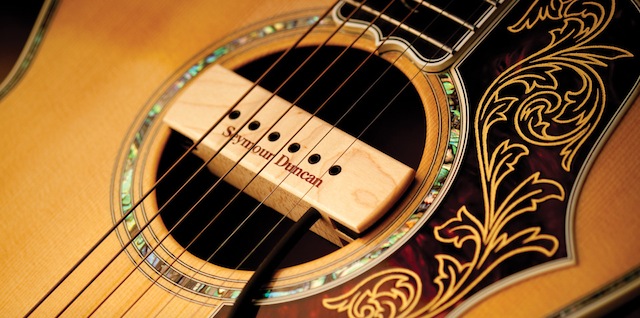
Table of Contents
Do You Want the Best Acoustic Guitar Pickup?
It’s very common for acoustic guitars to have inbuilt pickups now and it’s wise to try and factor one into any guitar you buy. But some have no electronics simply to keep the cost down, while more expensive instruments acknowledge that players might prefer to choose and install their own type of pick-up to suit particular styles and situations.
You might have a favourite guitar that needs a pick-up put in. Straight up, I’m going to recommend you don’t go too cheap with your budget. That’s a recipe for hums, buzzes and poor tone. And for the sake of balance, I’ve included a couple of big-ticket items here. Before I show you a list of options, here’s a very quick lesson on the different kinds available. It’s important you know the difference.
Hint: “Feedback” can be anything from a very low rumble to a screeching, ear-piercing squeak. It’s when the signal from your pick-up comes out of an amplifier (or PA system) and is accidentally picked up again by your guitar—so it’s “feeding back” into your amplifier in an endless loop. Normally, you’d never want this. But you’ll often see rock musicians holding their electric guitars close to their amps to deliberately create screaming feedback. A lot of acoustic guitar feedback can be reduced by using a “feedback buster” or “sound hole cover”. See here.
Electro-magnetic Pick-ups
Electro-magnetic pick-ups are mounted across the sound hole of the guitar and create a signal by responding to the strings vibrating within the electro-magnetic field produced by the pick-up. The natural tone of the instrument—what you actually hear—has almost no impact on the signal produced by EM pick-ups, but the more you pay, the better these can sound and they’re less prone to feeding back. So they’re popular with guitarists using acoustic guitars in loud rock bands and such.
Piezo Pick-ups
Keeping things very simple, piezo-designed pick-ups are really a tiny microphone that “listens” to your guitar through the vibrations of the wood—so a good physical contact with the timber is needed. It means the natural tone of the instrument is a big factor in what signal the pick-up produces, and they create a “real” acoustic sound. However, it’s a design that by its very nature is prone to feedback.
Microphone Pick-ups
In the pursuit of a perfect, amplified acoustic tone some pick-up manufacturers have designed miniature, high-quality microphones that mount inside the body of your guitar. The natural tone of your instrument is very important—these pick-ups can only recreate what they acoustically hear. But again, they’re likely to feed back when things get loud.
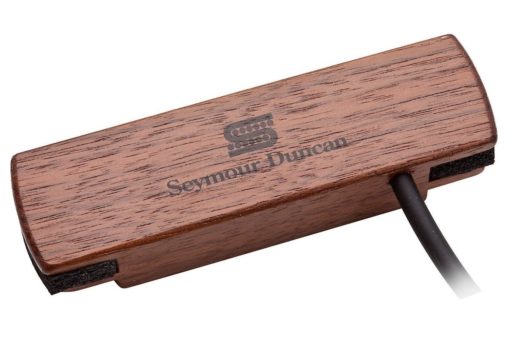
Seymour Duncan Woody HC SA-3HC
Price: $69.00
This is a sound hole-mounted EM pick-up from a company well-known and respected for its products: Seymour Duncan, so you can be confident it’ll sound good. The internal electronics reduce unwanted hum, and the pick-up has an attached fourteen-foot cable with a standard, hard-wired ¼ inch plug on the end. You won’t need to drill any holes in your guitar.
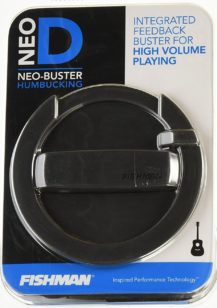
Fishman Neo Buster Pickup
Price: $89.95
This is a great idea. Fishman has incorporated a feedback buster into the sound hole mount for this EM pick-up—and again, Fishman is a highly respected name in the pick-up world. Just make sure the sound hole of your guitar is a compatible size.
 Dean Markly DM3001 Artist Acoustic Pick-up
Dean Markly DM3001 Artist Acoustic Pick-up
Price: $29.99
This is the most basic kind of piezo pick-up by Dean Markly. The microphone comes with a supply of special adhesive that gives you plenty of use, removing and replacing it over and again. These sorts of pick-ups are really popular for instruments like violins and cellos where you definitely don’t want to damage the timber, and they sound great on guitars, too.
Pro Tip: This pick-up will sound very different, depending on where you place it. Experiment a lot for the best sound.
Fishman Undersaddle Piezo Pick-up
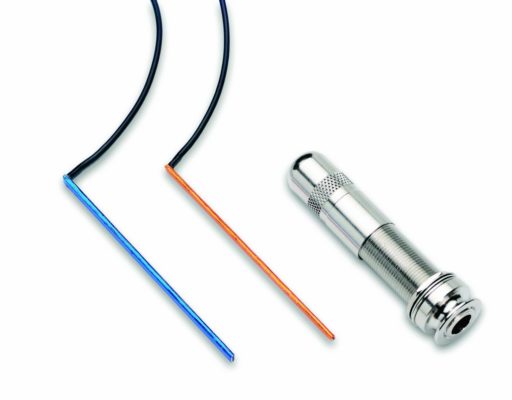 Price: $95.70
Price: $95.70
This is what’s considered a “standard” piezo pick-up design and configuration. These elements slip under the rear saddle and pick up the strings’ tone from directly underneath. All the guitars you’ll find in a music store with pre-mounted pick-ups use this design—so plainly it’s good. They usually have a preamp increasing the signal, but you can purchase preamp foot pedals instead. With an external preamp of some kind, these undersaddle piezos give you the best sound without cutting a big hole in your guitar body for the volume and tone controls. Note there are narrow and wide configurations.
LR Baggs Acoustic Guitar Microphone
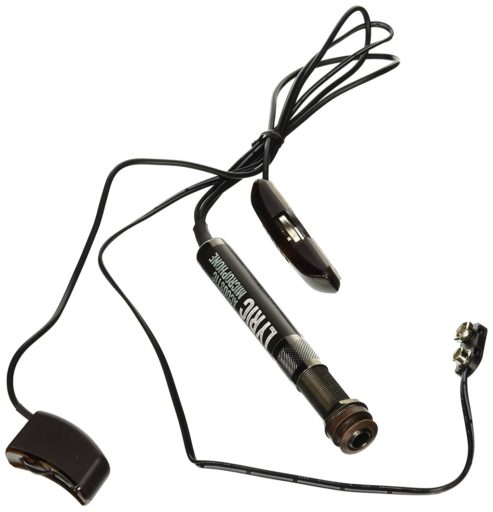 Price: $199.00
Price: $199.00
No surprise, with this kind of technology, you’re starting to pay a lot more. But the advantage is a true acoustic sound. A small controller mounts on your sound hole to let you tweak volumes, so no damage there, and the microphone element needs to be fixed somewhere inside the body—use Bluetack at first to experiment for the best sound—but you will have to drill a hole for the cable jack. Check our LR Baggs.
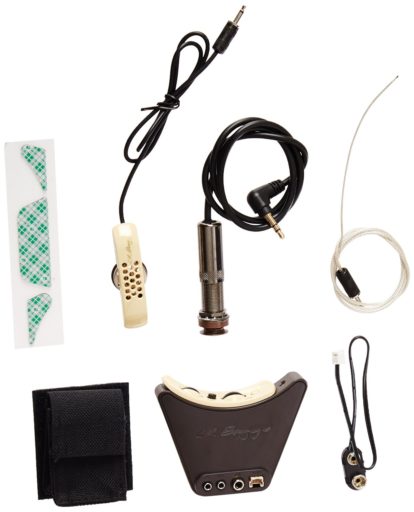
LR Baggs Anthem Pick-Up
Price: $289.00
Yes, this will blow the budget, but to illustrate just how far these pick-ups can go… this system has an inbuilt microphone and a piezo element, and you balance between the two for the perfect, studio-quality sound. It needs a professional hand to install and plenty of trial-and-error to get the best placements, but the end result is awesome. If you’re serious about a great guitar sound, this is the kind of pick-up you should consider.
Shure SM57 Microphone
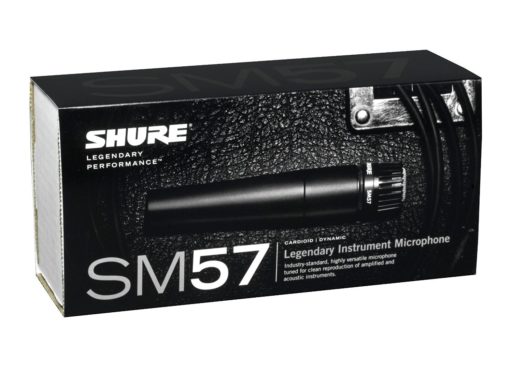 Price: $99.00
Price: $99.00
Hey… what the…? Isn’t this all about guitar pick-ups? Okay, here’s a real expert tip from yours truly—if the idea of mounting pick-ups to your precious guitar or cutting holes into the body scares you, a great solution is the good ol’ Shure SM57 instrument microphone instead. You’ll need to learn the technique of playing into a microphone, but then you’ll also figure out awesome tricks of changing the tone to suit different songs by adjusting your position slightly. Beware, Shure mic’s are very popular and fake products are everywhere.
That’s Just The Start.
So there you have it. The above pick-ups are just a small sample of what’s available in the various price ranges and designs. As always, if you can have a listen in a music shop, all the better. Otherwise, read the reviews carefully. If you have more ideas, products or tricks for great sounding guitar pickups, please share with us in the comments section below.
Our free blog here at Uberchord covers many more topics that can help you get set up playing and recording the guitar. Just take a quick search! Some of these articles include “what key is lost boy ruth b in?”, “what key is ain’t no sunshine in?”, and i’m never changing who i am chords.


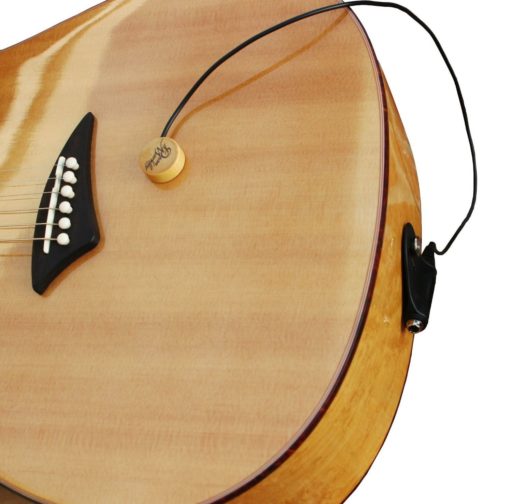 Dean Markly DM3001 Artist Acoustic Pick-up
Dean Markly DM3001 Artist Acoustic Pick-up
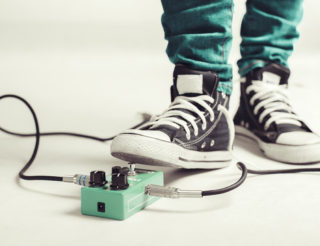
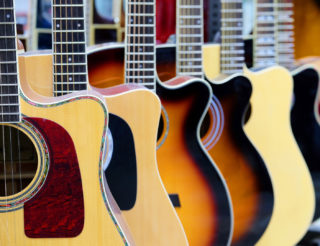
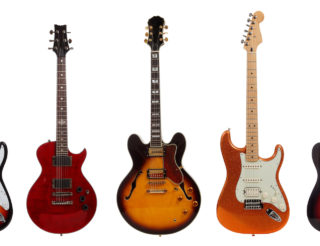


Great information really appreciate the hard work pit into it
Thanks. Very good info.
Hi, great article. I really liked your article. I am a massive fan of fishing. It is really cool. Thanks mate.
I have a Martin D41 special with 1″ forward shifted bracing. Close to the sound hole. I’m not sure what pickup controls will fit there. Any ideas?
You were doing well until you recommended the SM57 mic for picking up an acoustic guitar sound. Very few dynamic microphones can do justice to the rich and complex sound of an acoustic guitar, and the SM57 is probably one of the worst. 57s are great for all sorts of things, like grungy vocals, drums, guitar cabs…they are very versatile, but not for this application, unless you are really going for an unpleasant, very coloured sound. If you want to use a mic, then choose almost any condenser mic before the 57. Cheap Chinese mics like Behringer C2, SE Electronics SE1A, AKG C1000, will do an acoustic guitar proud.
OK, as usual, they all sound great and they all sound different. – and just in case, there are devices which are supposed to remove the effects of acoustic pickups. Someday, maybe in my dreams, somebody will come up with a pickup that actually works. – they will probably be shot.
Hi, I have an acoustic bass I want to put a pickup in. Can you tell me if the under saddle piezo pickup is different for a bass. Is the same “standard” pickup just cut down for a ukulele etc bridge. Also does a standard piezo respond to bass frequencies?
Thanks in advance.
Thanks very much for simple straightforward info
I would like to say, AMPLIFY, AMPLIFY, AMPLIFY!!!
What about Sunrise Pickups….? You did not mention them? Why?
Exactly the info I needed, but what about the Martin thinline pickup. Still looking at trying one of these.